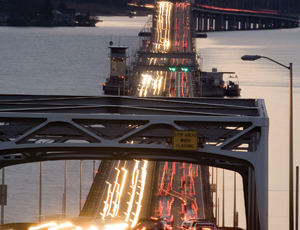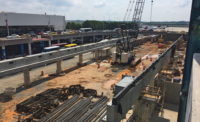After a 12-month experience rivaling the most hairraising theme-park thrill ride, transportation design firms are finally enjoying a sense of stability, coupled with some optimism about the future. The industry’s biggest influence in recent months has been $40 billion in transportation infrastructure funding from President Obama’s economic stimulus program. Though directed primarily to shovel-ready projects, the stimulus funding is also finding its way to design firms, according to Jim Lyman, chief operating officer for David Evans & Associates, Portland, Ore.

“The stimulus has gotten priority projects moving and freed up money to bring other projects up front,” says Lyman. “Though most projects are generally simple in scope, there are still opportunities for design firms to help get bid documents going and provide construction administration services.”
TranSystems Corporation Vice President Richard Morsches notes bridge programs remained strong despite the economic upheaval, “a direct offshoot of the I-35W bridge collapse in Minneapolis and greater public awareness of bridge safety,” he says. The Kansas City-based firm is handling the replacement of multiple bridges along Interstate 90/94 in Chicago and the eight-mile, $664-million I-75 Mill Creek Expressway rehabilitation in downtown Cincinnati.
The energizing effect of the stimulus has been aided by lower construction costs and more competitive contractor bids, allowing states to spread those dollars across a broader range of projects than originally planned.
The lower costs are welcome for transportation mega-projects such as the $4-billion, multimodal I-5 Columbia Crossing project in Portland, Ore.; the 40-mile, $3-billion Mountain View Corridor freeway west of Salt Lake City; the $8.7-billion Trans-Hudson passenger rail terminal linking New Jersey with Manhattan; and the impending SR 520 bridge and Alaskan Way Tunnel projects in Seattle.
But while the stimulus “has created a buzz in the industry, the market’s recovery is just beginning,” says Rich Amodei, senior vice president of STV Inc., New York City. “It will be another year to 18 months before we regain a sense of normalcy,” Amodei says.
In some states the challenges are particularly formidable. Despite the infusion of stimulus funding, many states have repeatedly cut back project schedules due to a sharp falloff in fueltax revenue. Declines in Florida’s sales and property tax receipts have put many projects on hold, while Michigan recently eliminated more than $740 million in road and bridge projects due to insufficient funds.
With few exceptions, states have been reluctant to raise gas taxes to bridge the funding gaps, opting instead for increases in other taxes and fees. Iowa recently enacted an $830-million bond program for infrastructure projects. Utah also is using bonds to help fund projects such as I-15 CORE, the $1.725-billion design- build reconstruction of I-15 from American Fork to Provo.
“It’s hard to define any nationwide trends because the markets are so fluid and changing rapidly,” observes Paul Yarossi, president of HNTB, Kansas City. “There are so many moving parts, it’s hard to predict what will happen next.”
The same is true for the aviation sector, in which the economy has taken its toll on passenger air travel.
“It just depends on who already has programs under way,” says Yarossi, whose firm is designing the...




Post a comment to this article
Report Abusive Comment